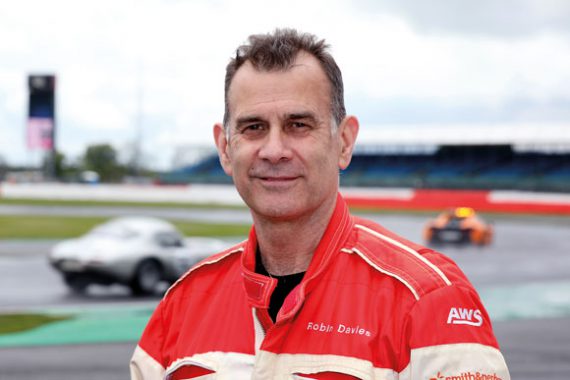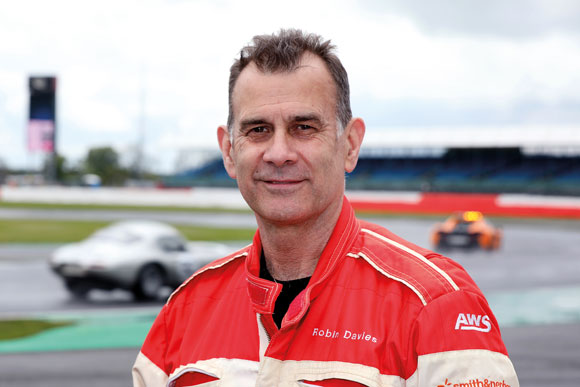Working life: On duty at Silverstone


Profile – Dr Robin Davies
Roles
GP partner in Welwyn Garden City; GP appraiser in Hertfordshire. Motorsport doctor at Silverstone Circuit since 1996, attending approximately 20 days a year, and extrication doctor at Formula 1, extracting injured drivers from damaged cars
Hours worked per week
24 hours a week, plus 10-20 hours (1-2 days on average) a month at the racetrack
8.00am
I arrive at the circuit to be briefed on my responsibilities for the day, which is the Blancpain GT series meeting. Sometimes I’m chief medical officer, but this time I’ll be deputy. Today’s team comprises four doctors, plus three ambulances staffed by three nurses and three paramedics, one of whom will also be in the car with me.
We look after all attendees – not just those racing – so it can get quite busy.
8.30am
After catching up with colleagues, I collect the morphine to carry all day, and check the medical equipment in our fast-response car, before moving to Stowe corner, one of the fastest at Silverstone.
9am
The day kicks off properly with the first track action, the half-hour practice session for Formula Renault Eurocup. There are no incidents, but this role is unpredictable, so we’re always alert.
For instance, I once helped with a 120mph crash. My team removed the driver from the wreck on a spinal board. After assessment at the medical centre, he walked out with aches and pains – and won a race at Le Mans just weeks later.
10am
There are no long breaks between activities, and next up is the Lamborghini Super Trofeo qualifying session. A few cars collide, but we aren’t needed to scramble since no one is injured.
11am
We move to the Becketts area for the third session, the Blancpain GT Series Endurance Cup free practice, which is longer, at 90 minutes. Again, we witness minor on-track incidents. One impact is bad enough for the car to need recovery, so its driver is assessed at the medical centre. This is done after a calming-down period, as adrenaline can mask injuries.
12:30pm
Lunch break, when I spend half an hour with Naomi, a friend who works on head injury assessments after race incidents.
She uses 3D virtual reality headsets to assess drivers’ brain function on a serial basis. This programme, called RESCUE-RACER, was developed from cutting-edge research by Addenbrooke’s Hospital’s neurosurgery unit and supported by the FIA. As this will be the first such programme to offer evidence-based assessments, it will make a huge difference to post-concussion management in all sports.
1.30pm
I’m also an extrication doctor. At smaller events, drivers are extracted from damaged cars by the available personnel on the rescue unit and our car. At F1 and FIA GT races, there is a dedicated team who go out in a minibus to the incident.
On race weekends, we practise this and have to demonstrate our skills. In recent years, we’ve used Lewis Hamilton’s Mercedes to show our expertise to F1’s deputy medical delegate Dr Ian Roberts.
Back to action, in the form of another 30-minute race for Formula Renault Eurocup. The safety car is again sent out due to a collision, but once more there’s no need for medical intervention.
2.45pm
Onto a 50-minute race, the Lamborghini Super Trofeo. As we’re not required, we convene at the medical centre to top up on coffee – a necessity for all GPs, in the consultation room or out on the track!
3.20pm
There’s not much time to caffeinate, though, as the day’s sixth session is a prequalifying session for the Blancpain GT cars. These are sports cars that are hugely modified, but still recognisable as road cars, with brands including Bentley, Lamborghini, Ferrari and Aston Martin.
Each driver has a session to set the car up and learn the track, before tomorrow’s qualifying session and three-hour race.
5.10pm
As the excitement settles, I check the morphine back in with the nurses and say my farewells. Heading home, it’s natural to reflect on what happened, especially in such a – literally – fast-paced environment. Although there were no major injuries today, I feel privileged to assist when they do occur.
Pulse July survey
Take our July 2025 survey to potentially win £1.000 worth of tokens

Visit Pulse Reference for details on 140 symptoms, including easily searchable symptoms and categories, offering you a free platform to check symptoms and receive potential diagnoses during consultations.












